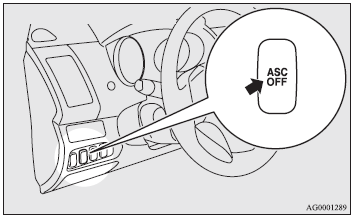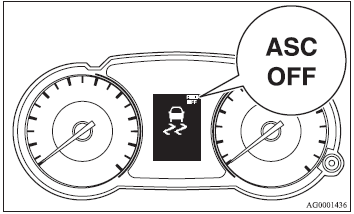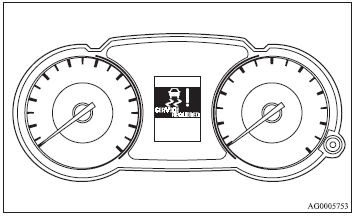Mitsubishi Outlander: Active stability control (ASC)
The active stability control (ASC) takes overall control of the anti-lock brake system, traction control function and stability control function to help maintain the vehicle’s control and traction.
Please read this section in conjunction with the page on the anti-lock brake system, traction control function and stability control function.
Anti-lock brake system (ABS) → 4-32.
Traction control function → 4-37.
Stability control function → 4-37.
CAUTION:
● Do not over-rely on the ASC. Even the ASC cannot prevent the nautral laws of physics from acting on the vehicle.
This system, like any other system, has limits and cannot help you to maintain traction and control of the vehicle in all circumstances. Reckless driving can lead to accidents. It is the driver’s responsibility to drive carefully. This means into account the traffic, road and environmental conditions.
● Be sure to use the same specified type and size of tyre on all 4 wheels. Otherwise, the ASC may not work properly.
● Do not install commercially available limited slip differential (LSD) on your vehicle. The ASC may stop functioning properly.
NOTE:
● A whining sound may be emitted from the engine compartment in the following situations. The sound is associated with checking the operations of the ASC. It does not indicate a malfunction.
• When the ignition switch is set to the “ON” position.
• When the vehicle is driven for a while after the engine is turned on.
● When the ASC is activated, you may feel a vibration in the vehicle body or hear a whining sound from the engine compartment.
This indicates that the system is operating normally. It does not indicate a malfunction.
● When the anti-lock brake system warning lamp is illuminated, the ASC is not active.
Traction control function
On slippery surfaces, the traction control function prevents the drive wheels from spinning excessive, thus helping the vehicle to start moving from a stopped condition. It also provides sufficient driving force and steering performance as the vehicle turns while pressing the acceleration pedal.
CAUTION:
● When driving a vehicle on a snowy or icy road, be sure to install snow tyres and drive the vehicle at moderate speeds.
Stability control function
The stability control function is designed to help the driver maintain control of the vehicle on slippery roads or during rapid steering maneuvers. It works by controlling the engine output and the brake on each wheel.
NOTE:
● The stability control function operates at speeds of about 15 km/h (9 mph) or higher.
“ASC OFF” switch

The ASC is automatically activated when the ignition switch is turned to the “ON” position. You can deactivate the system by pressing down the “ASC OFF” switch for 3 seconds or longer.
When the ASC is deactivated, the display
will be illuminated in the multi-information display. To reactivate the ASC, momentarily
press the “ASC OFF” switch; the
display
will be illuminated in the multi-information display. To reactivate the ASC, momentarily
press the “ASC OFF” switch; the display
is turned off.
display
is turned off.
CAUTION:
● For safety reasons, the “ASC OFF” switch should be operated when your vehicle is stopped.
● Be sure to keep the ASC on while driving in normal circumstances.
NOTE:
● When moving out of mud, sand or fresh snow, pressing the accelerator pedal may not allow the engine speed to increase. In such situations, temporarily turning off the ASC with the “ASC OFF” switch will make it easier to move out your vehicle.
● Using the “ASC OFF” switch turns off both the stability control function and the traction control function.
● If you continue to press the “ASC OFF” switch after the ASC is turned off, the “mistaken operation protection function” will activate and the ASC will turn back on.
After the “mistaken operation protection function” is activated, it will not be possible to turn the ASC off.
To turn the system off again, return the ignition switch to the “ACC” or “LOCK” position, restart the engine and press the “ASC OFF” switch.
ASC display, ASC OFF display
 - ASC display When the ASC is operating,
the information screen in the multi-information display will change and the ASC
display will blink.
- ASC display When the ASC is operating,
the information screen in the multi-information display will change and the ASC
display will blink.
 - ASC OFF display This is displayed
when the ASC has been deactivated with the “ASC OFF” switch.
- ASC OFF display This is displayed
when the ASC has been deactivated with the “ASC OFF” switch.

CAUTION:
● When display blinks, ASC is operating,
which means that the road is slippery or that your vehicle’s wheels are beginning
to slip. If this happens, drive slower with less accelerator input.
display blinks, ASC is operating,
which means that the road is slippery or that your vehicle’s wheels are beginning
to slip. If this happens, drive slower with less accelerator input.
NOTE:
● The display may come on in the multi-information
display when you start the engine. This means that the battery voltage momentarily
dropped when the engine was started. It does not indicate a malfunction, provided
that the display goes out immediately.
display may come on in the multi-information
display when you start the engine. This means that the battery voltage momentarily
dropped when the engine was started. It does not indicate a malfunction, provided
that the display goes out immediately.
● When a spare tyre has been put on your vehicle, the gripping ability of the
tyre will be lower, making it more likely that the display
will blink.
display
will blink.
ASC warning display

If an abnormal condition occurs in the system while driving, the display
will blink or the
display
will blink or the warning display, “SERVICE
REQUIRED” and the
warning display, “SERVICE
REQUIRED” and the display will be displayed
at the same time.
display will be displayed
at the same time.
CAUTION:
● [If the warning display, “SERVICE
REQUIRED” and the
warning display, “SERVICE
REQUIRED” and the![the same time] The system may be malfunctioning.](images/books/1105/8/index.2.gif) display are shown at
the same time] The system may be malfunctioning.
display are shown at
the same time] The system may be malfunctioning.
Park your vehicle in a safe place and stop the engine.
Restart the engine and check whether the warning
display, “SERVICE REQUIRED” and the
warning
display, “SERVICE REQUIRED” and the display
go out. If the warning display goes out, there is no abnormal condition. If the
warning display does not go out or appears frequently, it is not necessary to stop
the vehicle immediately, but we recommend you to have your vehicle inspected.
display
go out. If the warning display goes out, there is no abnormal condition. If the
warning display does not go out or appears frequently, it is not necessary to stop
the vehicle immediately, but we recommend you to have your vehicle inspected.
● [If the display blinks] If the temperature
in the braking system continues to increase due to continuous brake control on a
slippery road surface, the
display blinks] If the temperature
in the braking system continues to increase due to continuous brake control on a
slippery road surface, the display will
blink and operation of the traction control function will be suspended to protect
the brake system (normal operation of the vehicle will not be affected). Park your
vehicle in a safe place. When the temperature in the braking system has come down,
the
display will
blink and operation of the traction control function will be suspended to protect
the brake system (normal operation of the vehicle will not be affected). Park your
vehicle in a safe place. When the temperature in the braking system has come down,
the display will be turned off and the
traction control function will start operating again.
display will be turned off and the
traction control function will start operating again.

